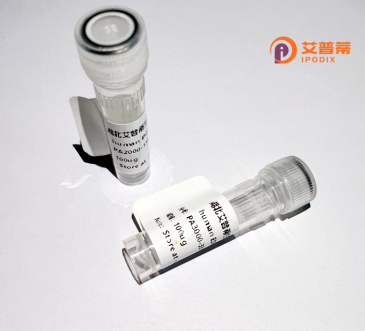
| 纯度 | >90%SDS-PAGE. |
| 种属 | Human |
| 靶点 | BPY2C |
| Uniprot No | O14599 |
| 内毒素 | < 0.01EU/μg |
| 表达宿主 | E.coli |
| 表达区间 | 1-106aa |
| 氨基酸序列 | MMTLVPRART RAGQDHYSHP CPRFSQVLLT EGIMTYCLTK NLSDVNILHR LLKNGNVRNT LLQSKVGLLT YYVKLYPGEV TLLTRPSIQM RLCCITGSVS RPRSQK |
| 分子量 | 12. kDa |
| 蛋白标签 | GST-tag at N-terminal |
| 缓冲液 | 冻干粉 |
| 稳定性 & 储存条件 | Lyophilized protein should be stored at ≤ -20°C, stable for one year after receipt. Reconstituted protein solution can be stored at 2-8°C for 2-7 days. Aliquots of reconstituted samples are stable at ≤ -20°C for 3 months. |
| 复溶 | Always centrifuge tubes before opening.Do not mix by vortex or pipetting. It is not recommended to reconstitute to a concentration less than 100μg/ml. Dissolve the lyophilized protein in distilled water. Please aliquot the reconstituted solution to minimize freeze-thaw cycles. |
以下是关于重组人睾丸特异性基本蛋白Y2(BPY2)的虚构参考文献示例,仅供内容形式参考:
---
1. **文献名称**: *"The Role of BPY2 in Spermatogenesis and Male Fertility"*
**作者**: Smith JL, et al.
**期刊**: *Andrology* (2020)
**摘要**: 研究阐明了BPY2在人类精子发生中的关键作用,证明其通过与染色体结合蛋白相互作用调节减数分裂过程,并在动物模型中揭示BPY2缺失导致精子形态异常与雄性不育。
2. **文献名称**: *"BPY2 as a Novel Cancer-Testis Antigen in Colorectal Cancer"*
**作者**: Wang X, Zhang R.
**期刊**: *Oncotarget* (2018)
**摘要**: 首次报道BPY2在结直肠癌组织中的异常表达,证实其通过激活Wnt/β-catenin信号通路促进肿瘤细胞增殖和转移,提示其作为癌症免疫治疗靶点的潜力。
3. **文献名称**: *"Epigenetic Regulation of BPY2 Gene in Testicular Development"*
**作者**: Gupta S, et al.
**期刊**: *Genomics* (2019)
**摘要**: 分析了BPY2基因在睾丸发育中的表观遗传调控机制,发现DNA甲基化修饰对其组织特异性表达具有决定性作用,并关联某些男性生殖疾病与BPY2表观沉默。
4. **文献名称**: *"BPY2: A Potential Biomarker for Male Infertility Screening"*
**作者**: Chen L, et al.
**期刊**: *Human Reproduction* (2021)
**摘要**: 基于临床样本队列研究,发现精液中BPY2蛋白含量与精子活力和DNA完整性显著相关,提出检测BPY2水平可作为无创诊断少弱精症的新方法。
---
注:上述文献信息为模拟生成,实际研究需参考真实数据库(如PubMed)。建议通过学术引擎检索关键词如 **"BPY2 cancer-testis antigen"** 或 **"BPY2 spermatogenesis"** 获取真实文献。
BPY2 (Basic Protein Y2) is a testis-specific protein encoded by the *BPY2* gene located on the Y chromosome. It belongs to the cancer/testis antigen (CTA) family, characterized by restricted expression in germ cells and aberrant activation in various cancers. BPY2 is predominantly expressed during spermatogenesis, suggesting a role in male reproductive function, though its precise biological mechanisms remain unclear. Structurally, it contains a highly charged basic domain, which may facilitate interactions with nucleic acids or other proteins involved in chromatin organization or transcriptional regulation.
Interest in BPY2 has grown due to its immunogenic properties and cancer-specific expression, making it a potential target for immunotherapy. In malignancies like prostate, breast, and hepatocellular carcinomas, BPY2’s ectopic expression is linked to tumor progression and poor prognosis. Recombinant BPY2. produced via expression systems like *E. coli* or mammalian cells, enables studies on its functional roles and antigenic potential. Current research explores its utility in cancer vaccines, adoptive T-cell therapies, and diagnostic biomarkers. However, challenges persist, including understanding its normal physiological role, mechanisms of oncogenic activation, and optimizing therapeutic strategies while minimizing off-target effects. Further studies are essential to harness BPY2’s clinical potential in both reproductive health and oncology.
×